Progress report for SW22-943
Project Information
Public research and education programs have been pivotal in adapting traditional Japanese forest-cultivated mushroom (FCM) production systems to the eastern US. Notwithstanding, Pacific Northwest (PNW) researchers are in an incipient stage of generating information to support regional adoption of FCM systems, despite exceptionally high stakeholder demands for Extension programming and a favorable production and market context in the western PNW. These systems are scale-appropriate to diversified farm operations and small-acreage farm startups; equipment, infrastructure, capital, acreage, and input demands are all relatively low for an agricultural enterprise. They are likewise resource-use efficient and do not compete with other crops for existing farmland by producing a food product from PNW forestland. These uncommonly low barriers-to-entry increase potential for grower adoption, and notably also provide important, feasible opportunities for many PNW farms being pushed to diversify and concentrate production as a result of urbanization.
In 2019, WSU Extension began the first University-based research on the commercial viability of FCM systems in the PNW. Results to-date indicate that shiitake mushrooms produced in appropriately-managed PNW FCM systems may yield on-par or greater than those reported from other regions where these systems have become established as feasible enterprise options for diversified farms and startups. This project proposes objectives that 1) further refine PNW FCM systems for commercial production via trials of management innovations and production options, 2) bolster FCM production innovation via network-building with contemporary FCM production information in Japan, and 3) poise the project to precipitate direct impacts on small and diversified farm businesses via. direct mentorship of FCM system establishment, training of peer-mentors, and inciting a grower network in the western PNW.
The proposed project takes a unique approach to facilitating rapid regional adoption diffusion, and to jumpstarting research-based FCM management innovations and region-specific course-corrections through insights gained from FCM system advancements in Japan that have become increasingly obscure to domestic FCM producers over the last 30-40 years. Successful refinement of these systems could incite a cascade of yet-untapped production and market opportunity for farms, local food systems, and attendant mushroom production supply and value-added processor businesses in the PNW.
R1) Assess longer-term estimates of shiitake mushroom yield with Pacific Northwest (PNW)-refined management approaches to inform yield expectations and enterprise budgets.
R2) Assess interactions between shiitake strains and PNW-sourced substrates to inform annual expectations from full-season yields.
R3) Assess two shiitake inoculation rates, forced-fruiting patterns, and log moisture management for effects on spawn run and yield to inform labor budgets.
R4) Establish screening trials for assessing 5 strains of oyster mushrooms and 7 other promising species mushrooms for their potential to be grown commercially within PNW forest-cultivated mushroom (FCM) system.
E1) Mentor ten PNW farmers in FCM production for direct project impact and to support their development as peer mentors supporting further PNW FCM business development.
E2) Establish a Mushroom Growers Network as a base supporting future grower adoption and new FCM business opportunities.
E3) Train a team of researchers in contemporary FCM research and production system management to support FCM growth and production viability.
E4) Connect PNW growers with advancements in commercial FCM production in Japan to help incite regional FCM innovation.
E5) Disseminate advancements in the FCM system knowledge base at educational events to incite grower adoption in the PNW.
E6) Produce Extension materials on commercial FCM as a resource supporting future grower adoption.
Project Timeline Gantt Chart: WSARE Mushroom timeline 2.2023
Cooperators
- (Educator and Researcher)
- - Producer
- - Producer
- - Producer
- - Technical Advisor
- - Producer
- - Producer
- - Producer
- - Producer
- (Educator and Researcher)
- - Producer
- - Producer
- - Producer
- - Producer
- - Producer
- - Producer
- - Producer
- - Producer
Research
Original proposed research objectives-
THE FIGURES AND TABLES ATTACHMENTS FROM THE PROPOSAL ARE INTENDED TO PROVIDE KEY ILLUSTRATIONS OF ELEMENTS INCLUDED IN THE RESEARCH PROPOSED OBJECTIVES.
Research trial locations:
The majority proposed field research trials in Objectives R1-4 will take place at a pre-established FCM trial site in southwest Washington (78th St Heritage Farm, Vancouver, WA). These trials currently consist of four blocks of treatment replications containing a total of ~500 logs inoculated with shiitake in 2019 and 2020. Additionally, a three truncated versions of proposed field research trials will help accomplish address Objectives 1-3. Trials at a satellite site in the south Puget Sound (Myers Point Environmental Field Station, Olympia, WA) currently hosting a replicated trial containing ~200 shiitake logs inoculated in 2019 will contribute to Objective R1 and R2. Two other truncated trials contributing to Objective R2 will take place at a satellite on-farm site in the south Willamette Valley (Woodland Valley Meadows Farm, Eugene, OR), and in northeast WA (WSU Vetter Extension and Research Forest, Deer Park, WA).
Objective R1:
A subset of 128 logs from the current southwest WA trials will be used as sample units to help estimate of the perennial productivity period of shiitake mushroom logs in the PNW. An additional subset of 94 logs from the current south Puget Sound trials will also be used to help achieve this objective. Up to two years of shiitake yield data will already be collected from the trials by the time proposed project begins; this project would allow for three additional years of yield data collection. Based on estimates from other regions, we anticipate that 5 years of data will suffice to begin to approximate the average age when PNW-sourced logs begin to cease producing in the PNW environment under the different log moisture management treatments we applied in the existing trials (see attached table and figure). This trial includes the treatment that will be used in all new trials established within this project (see Objective R2). All yield data collection protocols will be consistent those which were used for the past two years (15) by recording fresh shiitake weights and mushroom counts from individual logs after each of three forced-fruitings timed at ~8 weeks apart, annually beginning in late spring through early fall.
Objective R2:
New trials established during the project will use identical protocols used to establish the aforementioned trials used for Objective 1 (R1) and will be sited in an adjacent location within each trial treatment block. All trials use individual logs as a sample unit within a spatially-balanced complete block design with split-plots. Blocks were used stratify replications and to expand the scope of inference, but a minimum of 4 sample units per treatment level are included within each treatment block in all shiitake trials to allow for data analysis at finer scales, and allow for inference within the smaller-scale satellite trials. All sites and blocks will be equipped with a weather station for recording ambient wind, temperature, relative humidity and light intensity data as potential covariates affecting mushroom productivity. Logs will be cut from trees harvested during winter dormancy in 2023. The southwest WA trials will include red alder, wild cherry, and garry oak substrates (species with relatively high natural abundance, and previously determined to be viable for shiitake production) and add new comparisons with paper birch, beaked hazelnut, and Oregon ash substrates. Red alder will be used as a standard across all trial sites in the western PNW, with the south Puget Sound trials including Oregon ash as a comparison and the south Willamette Valley trials including garry oak as a regional comparison. Paper birch will be used as a common substrate between the southwest WA trials and northeast WA satellite trials, with the latter will including quaking aspen as a regional comparison. All substrates will be inoculated with commercial shiitake sawdust spawn in spring 2023 using standardized rates, techniques, and timings across all sites (~30d after timber harvest). All western PNW sites will include 6 different strains of shiitake, whereas the northeast WA trials will include only two strains. All shiitake strains tested are commercially available, and were selected for short spawn run times, versatility, and ability to be force-fruited. All inoculated logs will be soaked for 24 hours before being placed within crib stacks under spun polyester fabric covers by early summer of the spawn run year to help assure that log moisture is adequate for spawn run throughout dry summer and fall conditions in 2023. A temperature and relative humidity data logger will be placed under the covers to account for differences from ambient site conditions. All covers will be removed by October 2023, and then reinstalled after the first shiitake harvest in late spring of 2024. All harvest and yield measurement protocols will be consistent with those detailed in Objective 1.
Objective R3:
Inoculation procedures where holes are drilled in logs and filled with mushroom spawn constitute the vast majority of the labor demanded from these systems, and are the largest constraint on scaling-up production because the process is not easily mechanized. Currently recommendations for inoculation rates uses rows 2-3” apart; this 1” of range is equals a difference of ~8-10 hours of labor per 100 logs. The second largest labor (and water resource) demand is soaking logs for forced fruiting. Trials thus far in Southwest WA suggest that the 7-8 week resting period between fruitings may not be sub-optimal for producing a third flush of shiitake in one season that is worthwhile. It is also unknown if this observed trend may partly be attributed to strain-specific characteristics. Trials in Vancouver also indicated that a rapid, vigorous spawn run is important for assuring that the shiitake fungus is resilient to dry spells after the spawn run period, and that logs begin producing returns for growers as soon as possible to avoid wasted time on forced-fruiting efforts that do not yield mushrooms. Trials in southwest WA will also include 3 subset trials that use two substrates and two strains from the main strain x substrate evaluation trials as a control, and compare those two three identical strain/substrate subsets of logs with 3 differing treatments: 1) a set inoculated with shiitake at a lower rate, 2) a set where wide range strains are force-fruited once in late spring and early fall only, and warm weather strains are force-fruited once in early summer and late summer only, and 3) a set where logs are soaked twice during the first spawn-run year. All harvest and yield measurement protocols otherwise will be consistent with those detailed in Objective beginning in late spring of 2024.
Objective R4:
The novel mushroom species screening trial at the southwest WA will use the same experimental design and procedures as the shiitake trials, but the number of sample units will truncated to only include a single log per combination of mushroom species/strain/substrate within each treatment block. Mushroom yield across all substrates will be analyzed for indices of general potential to produce in the PNW within systems otherwise set up for commercial shiitake production using forced-fruiting practices. These include: response to forced-fruiting, seasonal yield timing, total yield and yield uniformity, time needed for spawn run, and incidence of non-producing logs. Other observations concerning commercial viability such as relative shelf-life, and harvest efficiency will be noted and recorded to inform future trials. Yield measurements from trials established in 2023 will begin take place beginning at the same time as for R2 and R3.
Research course-correction protocol:
If information garnered from the visiting scholar trip to Japan indicates that a component of a Research Objective 3 or 4 has either 1) already been determined to be a clear dead-end, or 2) if there are key aspects of shiitake production discovered that would be more highly applicable to the PNW context than the original plan, plans will be proposed course-correct accordingly if within the means of existing personnel and funding capacities. In formulating a course-correction, the vacancy from omissions to the original trial plan will be proposed to be re-allocated in accordance with the relative magnitude of the vacancy (trial labor, spaces, and funds). If potential improvements are either beyond the current means, or insights from Japan do not inspire a clear, feasible alternative to the original plans, three tangible default plans are pre-proposed: 1) increasing the number of sample units for species/strains with the greatest potential for commercial production within the novel species screening trial, 2) a shift to focus on simple, low-investment system adaptations that may allow these species to produce and allow for mushroom quality control within the existing shiitake system (hypothetical example: a simple misting system that induces fruiting), or 3) a shift towards expanding the shiitake trials to include another subset trial with a third variation on forced-fruiting patterns, inclusion of two more substrates (paper birch and wild cherry) within the existing subset trials, and/or addition of two additional shiitake strains for evaluation. Any proposed research course-corrections will be vetted through the project team and collaborating producers, and proposed to WSARE for approval. The same protocol will be applied if collaborating producers likewise elucidate a potential course correction that has greater relevance for the PNW context than the original research plan.
Data analysis:
In the shiitake strain x substrate evaluation trials, strain will be established as a main-plot treatment, substrate species as a split-plot treatment. Comparisons between treatments will be primarily analyzed as a randomized complete block design with split-plots. A mixed-model analysis will be used with treatments to be considered fixed effects (with split-plot treatments accounted for as nested effects within main-plot treatments), and replications be considered random effects. The same approach will be used to compare overall shiitake yield (regardless of treatment) between different locations and/or treatment blocks to determine the magnitude of potential effects of environmental conditions. The regional satellite trials will be analyzed for 1) within-site inferences regarding strain and strain x substrate interactions and 2) for shiitake strain yield responses to red alder substrates across both the south Puget Sound and south Willamette Valley sites.
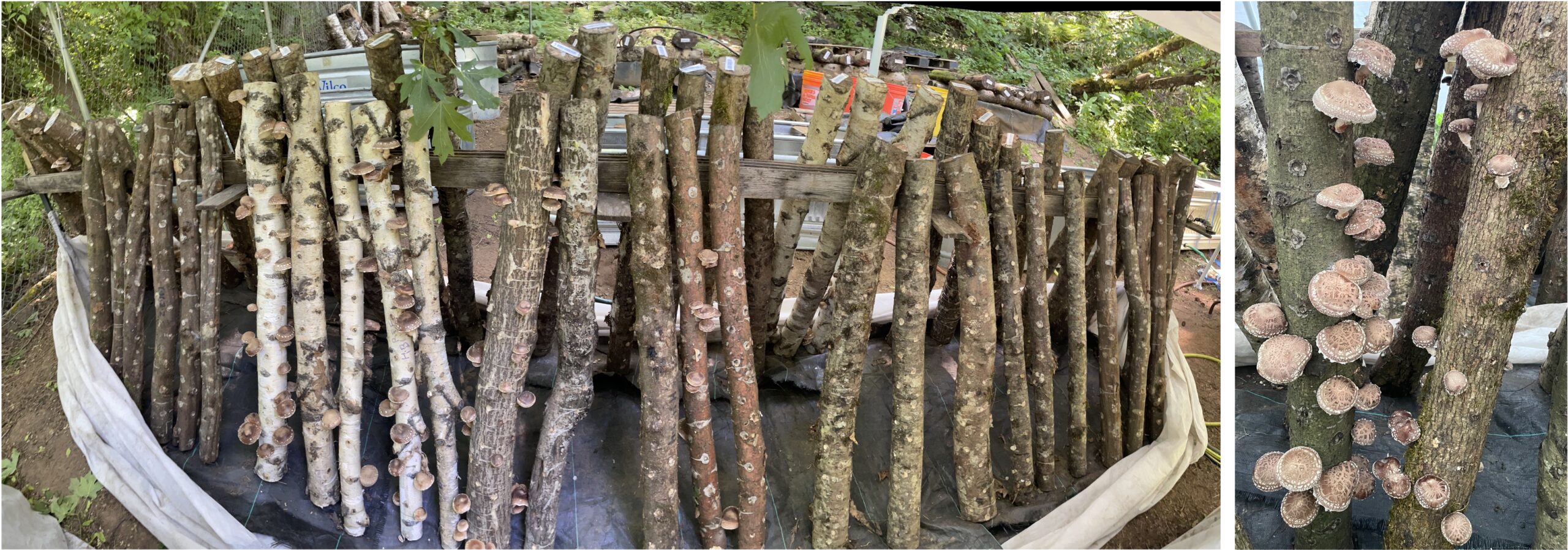
R1, R2, and R3) Under R1, we continued to collect data on the long-term yields of shiitake from the pre-established trials beginning in 2019 and 2020 in Vancouver and the south Puget Sound locations. The proposed trials for R2 and R3 research objectives in Southwest WA, South Puget Sound, WA and Lower Willamette Valley, OR were all successfully implemented by May, 2023. Additionally, a smaller trial of ~60 logs added in spring of 2022 to the Vancouver site will be incorporated under objective R1 (examining long-term shiitake yields of logs in the PNW); this was a truncated trial initiated after WSARE funding for this project was was initially not chosen for funding. This trial consequently ended up adding an unanticipated research workload to objective R1 after the project was later chosen for funding. This truncated trial is partly focused on the performance of logs with smaller-than-average diameters (~2.5-4.5”) and incorporates 5 log species (red alder, common hazelnut, western beaked hazelnut, Oregon ash, and gray birch) and three shiitake strains (‘Night velvet’, ‘West wind’, and ‘Son’) as split-plot sub-treatments. We also opted to add some minor sub-trials to R2 and R3, including the addition of a truncated subset of vine maple and cascara timber substrates to to R2 in Southwest WA, a truncated subset of Oregon ash and bigleaf maple to the south Willamette Valley satellite trial, and a truncated low inoculation rate subset to R3 in the south Puget Sound satellite trial.
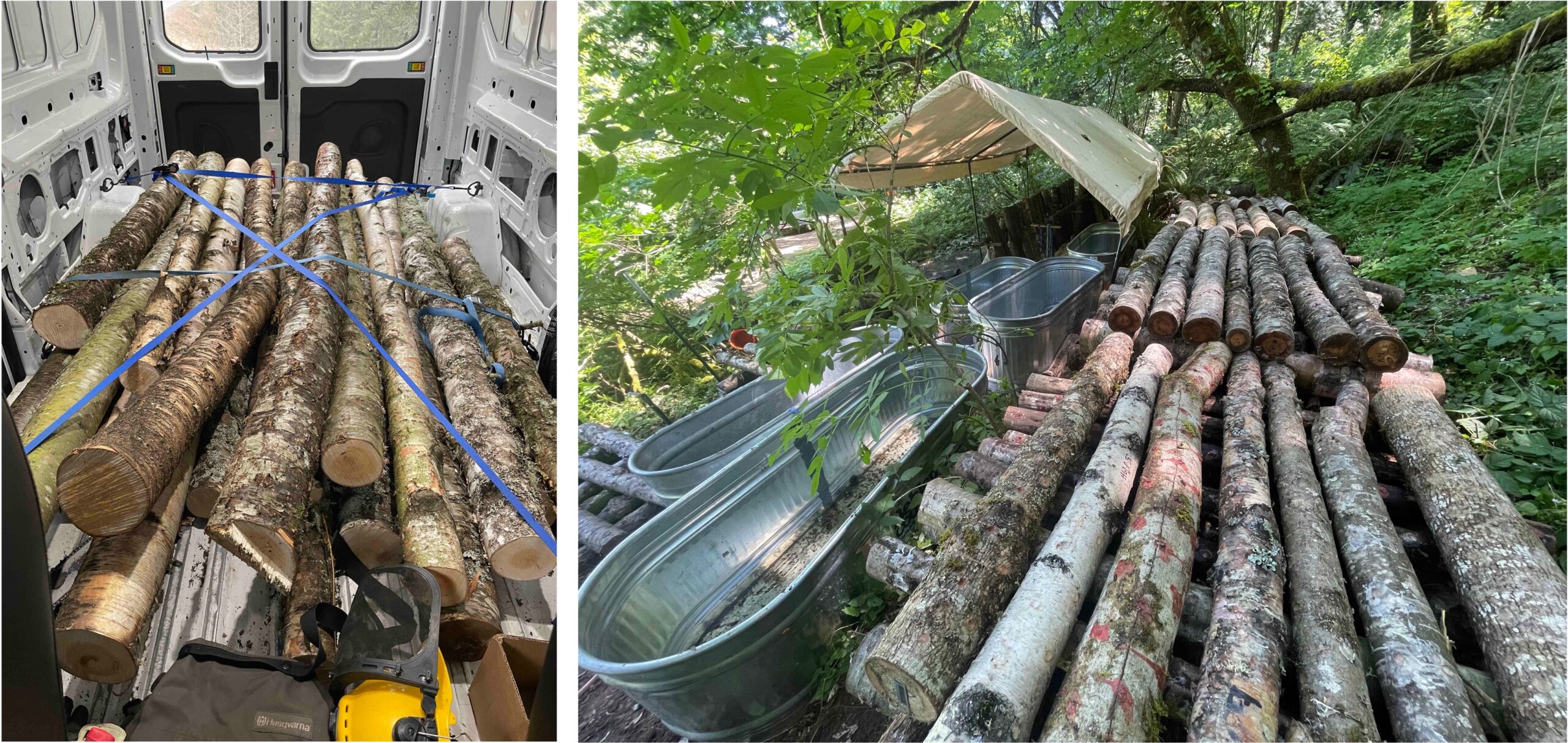
The largest deviation from the research objectives was the loss of the satellite trial proposed for in northeastern Washington (under R2 and R3), due to WSU collaborator Sean Alexander leaving the project following a career change. Alexander's departure within the project timeline did not allow for sufficient time to find a replacement collaborator that would have been capable of implementing and carrying out the satellite trial in northeastern WA.
By fall of 2023, we were able to complete a multiyear dataset via R1 and R2 to summarize the effects of wood species, wood density, and bolt diameter (girth) on shiitake bolt moisture content. These assessments illustrated that wood density plays a role in retaining moisture, but that other aspects of the wood species also influence whether moisture content levels are remain satisfactory for shiitake fungal growth. These other factors are most notably the initial moisture content level of the wood, and another non-quantifiable aspect, bark integrity. Results of this analysis helped substantiate that the most common species which have been advisable for shiitake production to date (based on early yield data), garry oak and red alder, remained advisable from a wood moisture content standpoint. Most bolts of these species retained moisture levels above critical levels for shiitake growth (24%) after exposure to summer weather. Garry oak appears to retain moisture sufficiently due to its high wood density and thick bark, whereas red alder benefits from a high initial moisture content. The latter species loses moisture rather readily due to low wood density and rather porous bark, but this is offset by the sheer amount of moisture that is initially present in the wood at the time of inoculation. The analysis also indicated that bigleaf maple (Acer macrophyllum), vine maple (Acer circinatum), western beaked hazelnut (Corylus cornuta var. californica), and Oregon ash (Fraxinus latifolia) were relatively risky for shiitake production due to high incidence of moisture contents falling below critical levels for shiitake growth. Conversely, birches (Betula papyrifera and populifolia), common hazel (Corylus avellana), and sweet cherry (Prunus avium) were relatively low risk due to ample moisture retention. The latter species are likely aided by notably favorable bark integrity.
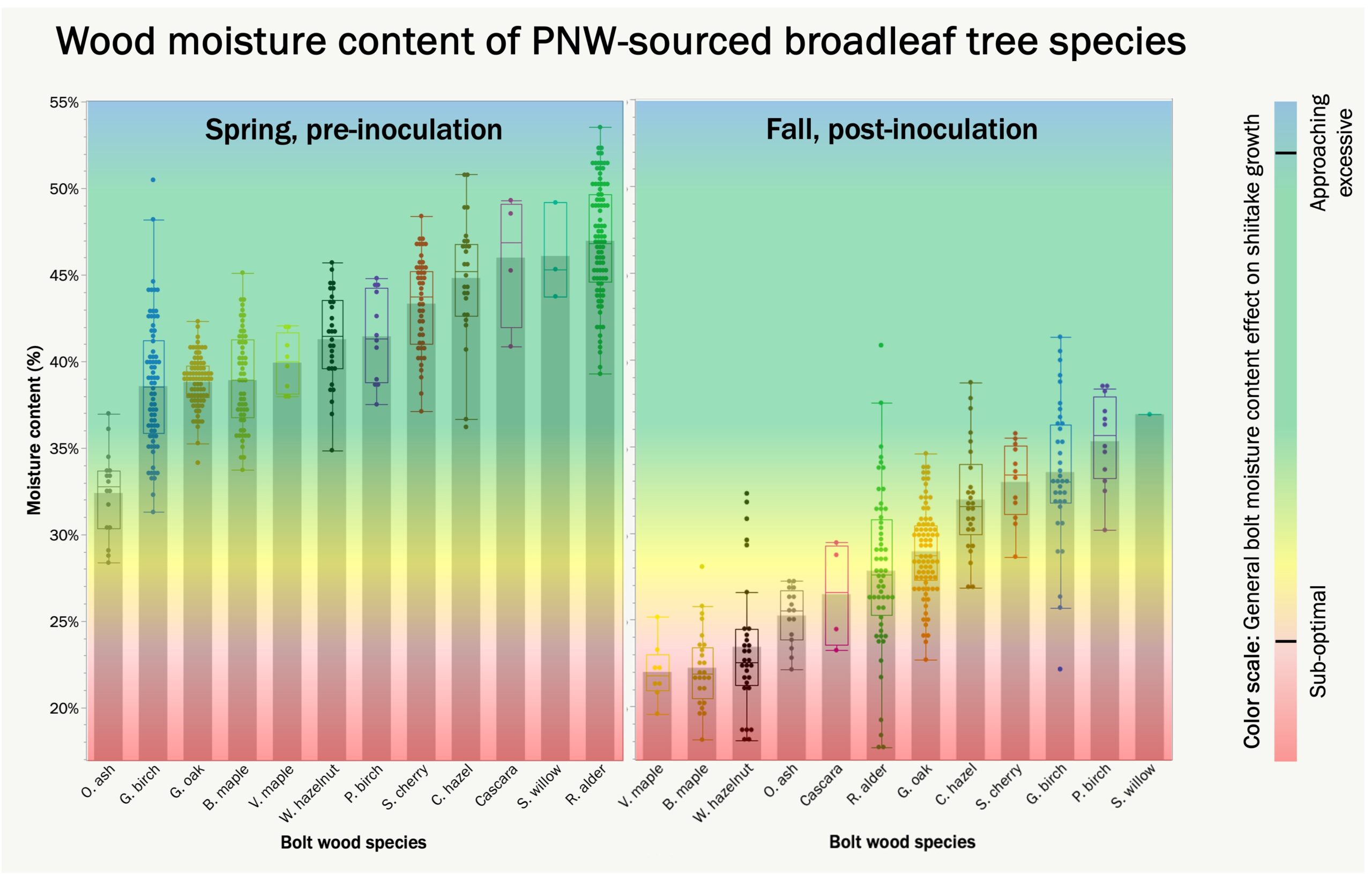
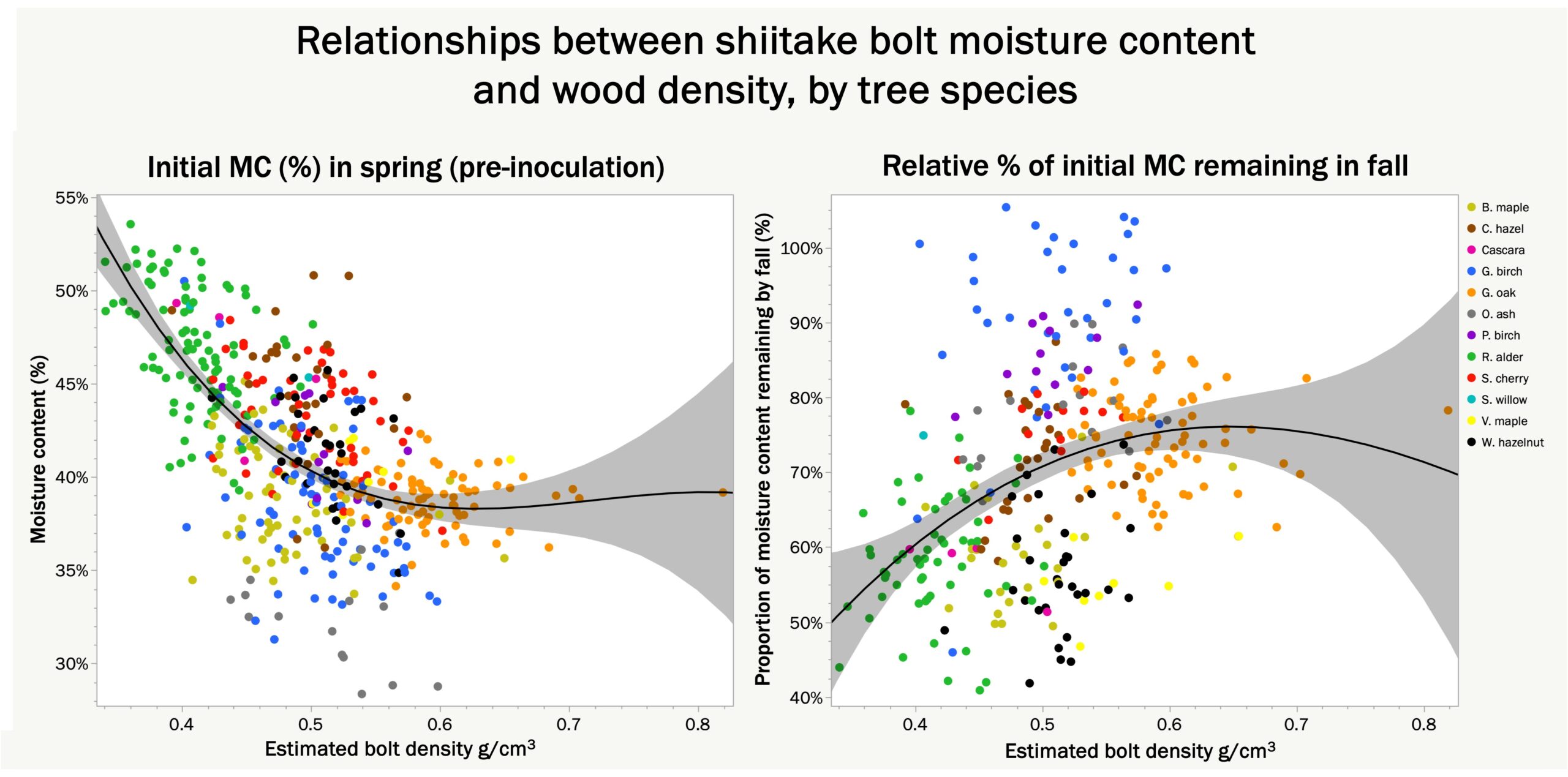
Overall, the diameter of the bolt also influences moisture retention, although only below a critical girth of 4", especially for certain wood species that are likely to be more vulnerable to excessive moisture loss anyway (aforementioned). In PNW-sourced species, bolts under 4" were more generally prone to falling to below critical levels of moisture content needed for shiitake fungal growth. For all red alder and garry oak bolts ≥ 4" from which moisture content measurements were taken from 2020-2023 (79 bolts total), we were also able to ascertain that when our advised bolt moisture management protocols were implemented (a 24 hour soaking of bolts in early summer of the spawn run year, followed by covering throughout summer) only 2.5% of bolts (2 bolts total) dropped below the critical moisture content level of 24%. This protocol was originally informed by comparisons within the 2020 bolt dataset where 20.6% of red alder and garry oak bolts (6 of 29) that went through summer weather without soaking and covering during the spawn run year fell below the critical moisture content level of 24%, compared to 0% of bolts that were soaked and covered.
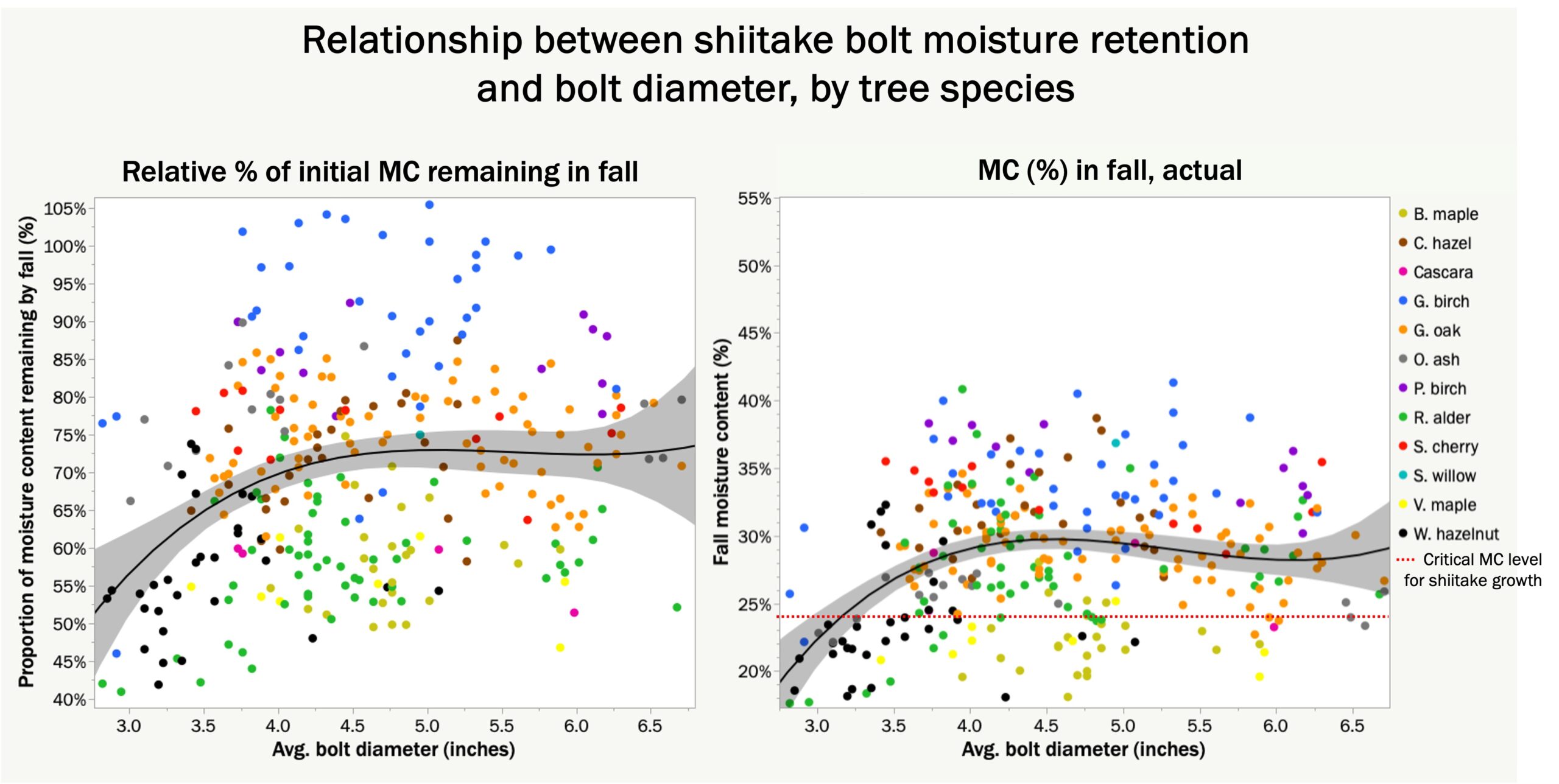
R4) A decision was made to table the proposed R4 screening trial in Southwest WA (assessing 5 strains of oyster mushrooms and 7 other mushroom species for their potential to be grown commercially within PNW forest-cultivated mushroom system). This was partly due to research capacity constraints (aforementioned), and partly due to understanding that viability of this research objective would be substantially better-informed by information gained from the visiting scholar tour of Japan (objective E4). Throughout our tour of Japan, shiitake constituted the vast majority of mushrooms grown on logs. Only one other minor species was mentioned as being commonly produced on logs- nameko mushrooms (Pholiota microspora), which are produced on cherry logs (Prunus avium). Hiratake mushrooms (AKA oyster, Pleurotus species) were also mentioned but it was unclear what species of log it was grown on, and it did not appear to be a common practice. Since cherry (Prunus avium) is a common broadleaf tree species in the PNW, nameko will be considered for R4 in 2025, if research capacity constraints allow. A second research question that was informed by our tour of Japan was the use of hoophouse type structures for enhancing aspects of shiitake production. A subset trial using fall-cut, early-inoculated shiitake logs and a high tunnel (a type of greenhouse) to accelerate shiitake spawn run, will be considered in 2025 as an alternative to the original R4 plans if research capacity constraints allow. In Japan, shaded hoophouses are also commonly used for fruiting shiitake bolts, and although we currently lack infrastructure for trialing this practice, it is of interest for future trials. This approach may be particularly useful for producing mushrooms that do not respond to forced fruiting via soaking bolts in water (cold weather shiitake strains, oyster, nameko, and lion's mane) but otherwise fruit naturally during the rainy parts of the year in the PNW (late fall, early spring). Shaded indoor structures like this could help prevent mushroom quality compromise and difficulty of harvest that occurs when fruiting and harvesting occurs during rainy weather.
Research Outcomes
Research results to date have indicated that shiitake bolts from PNW-sourced tree species should not be smaller than 4" for adequate moisture retention through the initial spawn run year after inoculation; this general guideline is especially important for red alder (or any other species that more readily loses moisture). To reduce risk of excessive moisture losses from bolts, growers should fundamentally consider sourcing bolts from tree species that have favorable attributes for adequate moisture retention. Species chosen should have either bark qualities or wood densities that are conducive to moisture retention (garry oak, birches, sweet cherry), and/or exceptionally initial high moisture content (red alder, common hazel, and tentatively, scouler's willow) to mitigate this risk. Species to avoid are those that generally have poor bark integrity and/or have wood that is notably prone to end-splitting as it dries (bigleaf maple, vine maple, cascara, western beaked hazelnut), or an exceptionally low initial moisture content (Oregon ash). In addition to wood species and bolt size, the current advisable method developed for mitigating excessive bolt moisture loss throughout PNW summers is soaking bolts for 24 hours in early summer (~mid-June to Early July) of the spawn run year followed by covering with a breathable fabric throughout the remainder of the dry summer season. From 2020-2023, this method was substantiated by effectively helping to assure that 98.6% of bolts (142 of 144) retained adequate moisture levels for spawn run (≥ 24% MC) in properly sized bolts (≥ 4") from tree species that have otherwise proven to be favorable for shiitake production (red alder, garry oak, common hazel, birches, and sweet cherry).
Education and Outreach
Participation Summary:
Objective E1)
A minimum of four growers in the Portland-metro area, two growers in the south Puget Sound region of WA, two growers in northwest WA, and two growers in the south Willamette Valley region of OR will participate in the project as new FCM producers. Mentorship will be focused on shiitake production and systems, with each grower agreeing to focus on shiitake as the most reliable FCM species for commercial production. Collaborating growers will get introduced to FCM systems and current research through a tour and training at the Vancouver trial site in June 2023 and 2024. Producers will otherwise have full sovereignty to add other mushrooms to their operation/enterprise, choose their scale, and markets. Direct mentorship will begin in Fall of 2023 and continue throughout; the project team will use on-site visits, research-based information, experiential knowledge, and general commercial mushroom production system knowledge to work with each collaborating producer in formulating business and production plans, including labor budgeting, equipment, substrate selection, timber sourcing and harvest, log cutting, shiitake strain choice, inoculation methods and logistics, production site selection, and infrastructure logistics, market options, and post-harvest considerations.
Objective E2)
An incipient PNW FCM grower network will be incited by the with the project team with collaborating producers constituting the initial network. A network website will be developed throughout the project to feature listings for FCM-related events, meetings, production, marketing and value-added processing resources, a grower forum, and an interactive map for helping to connect growers, buyers, and suppliers.
Objective E3)
Training of a new regional team of university-based educators/researchers will be accomplished through 1) team meetings and critical review of educational materials developed by the PI throughout 2022, 2) getting all members up to speed with current PNW FCM research via the two aforementioned tours and hands-on trainings in Vancouver, 3) experiential knowledge gain through research and interaction with collaborating producers and 4) information and network connections gained via the visiting scholar tour of Japanese FCM production systems (E4).
Objective E4)
Researchers and PNW growers will be connected to contemporary advancements in FCM production systems through network-building with key researchers and keycenters FCM production in Japan. A 10-day visiting scholar tour of select locations and meetings with key researchers in Japan in Year 1 is a key component to E4's success with assistance from a Japanese translator and tour guide familiar with shiitake production (Shinji Kawai, see stakeholder letters). The tour will be documented and targeted for use in educational Extension products and presentations (Objective E6).Information will be shared directly with collaborating growers, and to other FCM stakeholders through live educational events and with researchers via presentations ata regional and a national agroforestry conference (Objective E5).
Objective E5)
Advancements in FCM system knowledge will be disseminated to community stakeholders through 1) two hands-on, public workshops in each region in years 2 and 3 including participating producers as co-speakers, 2) a webinar in fall of each project year, and 3). One workshop in fall of 2023 will focus on on shiitake harvest, and a second in spring 2024 will be focused inoculation procedures. Workshops will be located at each trial site. Two additional workshops at Headwaters Farm Incubator in Gresham, OR (see Steele stakeholder letter of support), and two different farm incubators in northwest WA (Viva Farms and Black Farmers Collective) will target disseminating project knowledge to underserved farmer communities in Year 3.
Objective E6)
Written educational material development will be initially drafted by the project PI, critically reviewed by the project team in year 1 and 2, and vetted by the collaborating producers throughout Objective 5’s mentoring process. Video footage will be taken throughout the project and edited by the PI and program support staff into instructional-videos for upload to YouTube, the Network website, and an online shiitake production course launched in winter of 2024-2025.
All educational objectives will be assessed through post-program surveys, website use data, network growth, collaborating producer feedback and successful shiitake business development.
E1) At least 14 PNW growers have initiated shiitake production systems on their farms since this project began; 13 of these growers are directly involved in the project as of 2024. One of the original listed participating growers opted out of the project entirely, and two other growers opted to delay implementation. Three additional growers were recruited into the project (two near southwest WA and another in the Oregon Coast Range) in 2023 and implemented systems that year. One other grower also became proximally involved in 2023 (attended a workshop and implemented a production system, but have not been involved directly). One of the growers who initially delayed implementation in 2023 began in 2024, but the other grower who delayed in 2023 also delayed in 2024. A new grower was also recruited into the project in 2024, the NW WA region and implemented a production system the same year. Two other new growers are planning to implement a production system in 2025. Five farms opted to attend a full-day training in Vancouver, WA in January 2023; one farm additionally brought two employees who were interested in starting their own shiitake business. A total of 11 individuals were in attendance plus four Extension team members (who had an additional training the previous day as part of E3). Otherwise, the project mentors together have made at least 17 individual visits to participating farms for consulting and mentorship.
Another full-day training was offered to the participating growers in June in Vancouver, but only one farm ultimately ended up attending. Another three individual trainings were given in Vancouver in 2024 for two new growers and one that had missed the 2023 training. Otherwise the Extension team periodically checks-in with participating growers via email, text, or phone in the meantime.
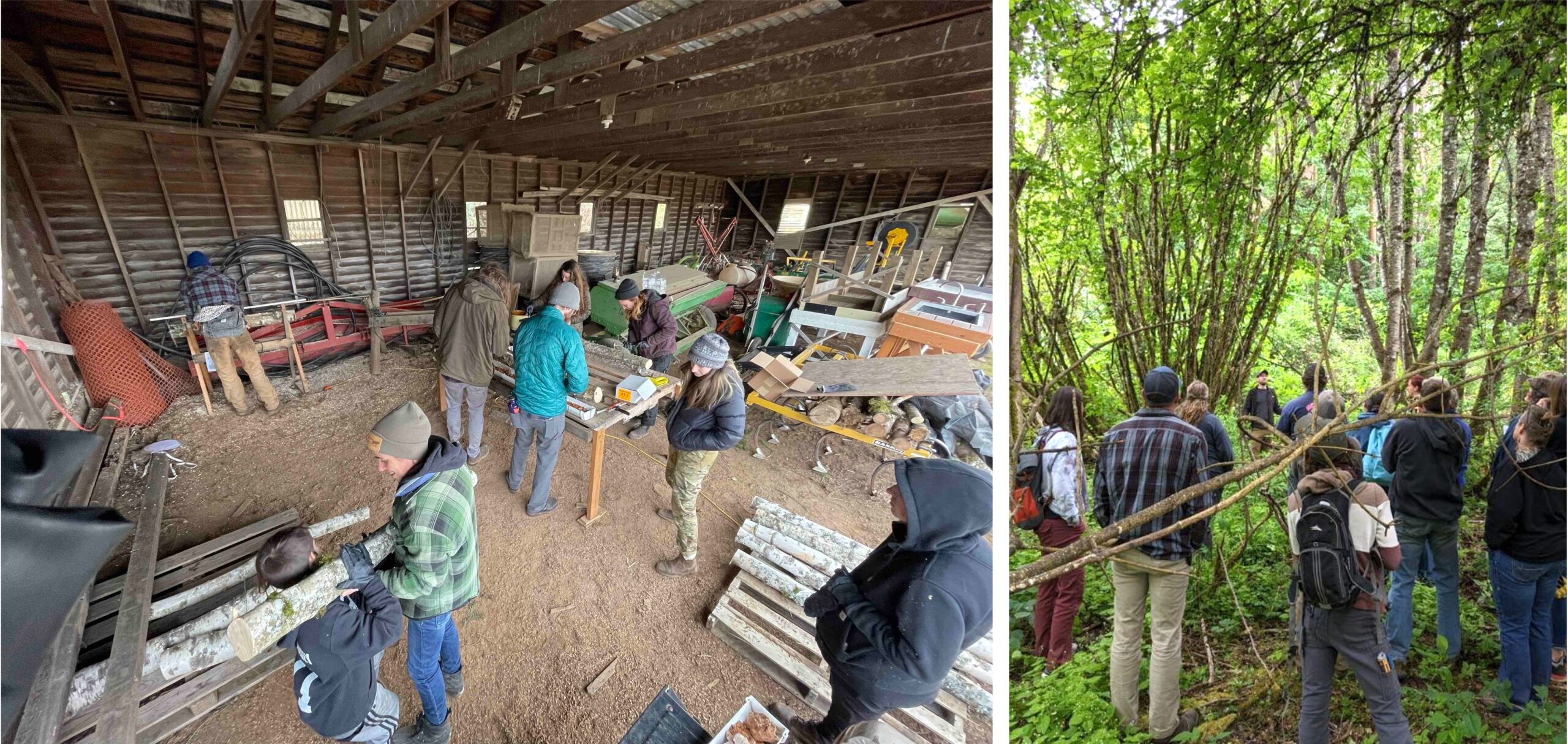
Producer interviews were conducted throughout winter-spring 2024. In general growers chose to begin with 25-100 logs as a starting size for their production system, with most opting for a target of around 50 logs. Growers largely chose to keep their systems limited to shiitake and strains that had be previously tested by WSU, per guidance provided from Extension (one farm chose to experiment with oyster mushrooms). Most chose advisable substrate species per WSU research, with most choosing red alder and at least one farm choosing to add common hazel (advisable), garry oak (advisable), and wild sweet cherry (moderately advisable) and another choosing to add some bigleaf maple (largely unadvisable) and Oregon ash (viability doubtful, but locally accessible). They also largely chose to adhere to the production practices developed by WSU. In some instances a few growers chose to improvise alternatives from some of the advised standard production equipment, mostly to avert financial burdens. To date, the most common aversion to the WSU-advised production components as reported by growers has been the purchase of tanks used to soak the logs, as this is the largest single financial investment into a forest-cultivated shiitake production system. A few growers suggested that a public “equipment library” of sorts would be a useful way for them to try out a given piece of equipment for a given season, and decide if they want to invest further. A second notable report from growers was when they had people source logs for them, they weren’t listened to with regard to the requested log size, and that the logs’ bark needed to be undamaged. Multiple growers reported that over-sized logs with abundant bark damage were delivered. This was similar to some past experiences that some of the Extension team experienced as well. A tendency to over-size logs was reported by other growers that had cut their own timber as well. There was also some “reality check” moments reported by some growers regarding whether they would be able to meet their start-up production size goals with respect to labor burden, learning curve, balanced with real-time life circumstances. Several growers accordingly lowered their target size from their initial goals.
Most growers so far considered their first year as successful; two growers considered their first year as compromised in some way. One of these growers felt overcommitted to winter projects which compromised their time and energy, while the other experienced several challenges including having to move their production site due to a land rental agreement change, trouble sourcing timber, being short of capital for equipment due to circumstances, and trouble with animal damage to their shiitake bolts. Growers that generally felt successful in year one largely were farms that didn't have significant overwinter farm projects or extended-season production that conflicted with the labor demand timing for setting up a forest-cultivated shiitake production system. Several of these growers stressed that getting the shiitake work done earlier was favorable to keeping it from conflicting with other farm work in spring, and several of these growers also remarked that they enjoyed the nature of the work (e.g. working in the forest, a welcome change from their typical farm work etc.). Many growers also recruited family members or community volunteers to help out with the inoculation process, which inadvertently became an educational experience for those helping out; at least one grower mentioned wanting hold workshops in the future as part of their business model. Most growers also opted to refrain from inoculating more shiitake logs in 2024, citing that they wanted to see how the production from the previous year's bolts went before investing further. There was general anxiety expressed by many of the growers about the spawn run year and the delayed reward of having to wait for the first year of shiitake production. Growers also largely expressed that their shiitake production system was not only focused on the sheer profit margin of the mushrooms, but also that there was other value including increasing the diversity of crops they could offer to their markets, and being able to utilize their woodlands to increase overall farm income.
E2) The concept of a PNW forest-cultivated mushroom grower’s network was introduced to the participating producers via the January training in Vancouver and otherwise through emails. This includes development of a network website (www.pnwforestmushroomgrowers.net; also part of E6), and a shared google drive folder for sharing resources as they are developed. A contact list was also shared with each of the growers to encourage peer-to-peer community support. There was at least a degree of resource-sharing amongst them as well to reduce financial burden and support one another (mostly bulk-purchasing of supplies) as a result of this. Growers generally found it difficult to coordinate with other growers, though still maintained that there may still be benefits.
E3) All Extension team members and Key Collaborator Kawai attended a full-day orientation and training in Vancouver on January 30, 2022 that was led by PI O’Dea. The day included orientation to the past and current FCM research in Vancouver, and to the PNW-oriented production practices developed via PI O’Dea and Co-PI Shults’s research to date. Co-PI Jones and Co-PI Shults participated in site visits with growers in their respective regions along with PI O’Dea in spring of 2023. This co-mentoring process was used to calibrate a common Extension approach to mentoring growers utilizing the set of production guidance materials drafted by PI O’Dea on forest-cultivated shiitake production systems. This also provided the Extension team with an opportunity to review the production materials in a real-time context. The materials were also used to outline a set of uniform practices for Co-PI Jones and Shults to use in establishment of their respective regional trials, giving them a first-hand user opportunity to review the draft guidance materials. Co-PI Shults also facilitated new connections and potential collaborations on strain development (via connections made in Japan, E4) with Field and Forest Products, the largest North American producer and retailer of spawn and equipment for forest-cultivated shiitake production. Similarly, Co-PI Jones facilitated new connections and potential collaborations with the only other US producer retailing multiple strains of spawn for forest-cultivated shiitake production, Northwest Mycological Consultants.
E4) A 10-day visiting scholar tour of select shiitake production, processing, and research sites in Japan was organized through critical efforts made by key collaborator Kawai throughout the first half of 2023. The tour occurred between July 27th- August 6th, 2023 and occured in several locations in Oita, Miyazaki, Kumamoto (on the southerly island of Kyushu), and Hokkaido (on the northerly island of Hokkaido) prefectures in Japan. In addition to Key Collaborator Kawai, PI O'Dea and Co-PIs Shults and Jones participated in the tour. Co-PI Zobrist was unable to attend the tour due to unanticipated time constraints. The team documented the tour through video and photography for dissemination throughout the remainder of the project and thereafter. The tour consisted of meetings with researchers at three different government-run research stations (Oita, Miyazaki, Hokkaido), meetings with three different industry groups (Kumamoto, Miyazaki, Tokyo), and seven farm visits with shiitake growers (2 in Oita, 3 in Miyazaki, 1 in Kumamoto, and 1 in Hokkaido). The tour of Japan provided the researcher/mentor team with novel insights (some mentioned in R5) on shiitake production and forest-cultivated mushrooms in general. It also helped affirm that our research and methods developed for the PNW were generally on-point and appropriately innovative.
Although Japan is the pre-eminent country producing shiitake on logs at commodity-scale levels, the vast majority of shiitake mushrooms (and other mushroom species) are nonetheless produced in indoor climate-controlled facilities on sawdust substrates. Partly due to this shift in production method and a declining population of individuals going into farming, log-grown shiitake is generally declining. The remaining log-grown shiitake industry is dominated by long-term/lifelong growers, and/or growers that prefer the process of producing shiitake this way. There are initiatives from both industry and Japanese government (often local) to bolster log-grown shiitake production culturally, and by touting the distinct qualities and heritage of log-grown shiitake vs. those grown indoors on sawdust. Drying and processing equipment and facilities are also often bolstered by government programs or may be cooperatively owned. Wood used for log-grown shiitake is almost exclusively on two species of oak (Quercus acutissima and serrata), and it is not uncommon for trees to be planted with shiitake production as the intended end-use, and for timber to be provided by a third party service rather than by the shiitake grower.
Japan has also developed "hybrid" systems for producing shiitake on logs, which makes use of open or indoor shaded hoophouse type structures instead of outdoor spaces under forest canopy. The majority of shiitake produced outdoors on logs under forest canopy (i.e. forest-cultivated) is being grown for dried shiitake markets. Forest-cultivated shiitake for dried shiitake markets is somewhat of a lower-input system that generally makes use of lower inoculation rates and plug spawn (which facilitates a slower spawn run rate), and colder weather strains (which fruit more spontaneously, in accordance with seasonal shifts in temperature). Fruiting in these systems may be sometimes assisted by overhead irrigation and/or physically striking the bolts instead of soaking bolts (forced-fruiting). Colder weather strains are used in outdoor shiitake production because the natural shiitake growing season is more oriented towards late fall and early spring, which tends to be the drier part of the year in Japan. This production season timing is notably different than the PNW, where the shiitake production season needs to be oriented towards late spring/early summer through late summer/early fall due to the PNW having the opposite precipitation pattern. Alternatively, log-grown shiitake for fresh markets in Japan though tends to have more in common with PNW shiitake production. Japanese fresh market shiitake growers tend to use of sawdust spawn, wide range and warm weather strains, and higher inoculation rates, practices that are similar to the PNW. Sometimes midsummer weather in Japan is more prohibitively hot (partially due to nights remaining warm) for producing shiitake though compared to the PNW though. Fresh market log-grown shiitake production in Japan also often uses shaded hoophouse structures for 1) quality control and 2) season extension; use of these structures is often bolstered by government purchase assistance programs. This approach is somewhat similar to the PNW; while shaded hoophouses are not a standard practice in PNW log-grown shiitake production, the "fruiting tent" approach that we've developed for outdoor production in the PNW (where sets of ~25 bolts are completely wrapped in breathable fabric during fruiting) serves a similar purpose regarding quality control, but is a far lower-input/financial investment than a hoophouse-type setup. Innovative fresh-market shiitake growers in Japan also may make use of hoophouses as an environmental control accelerating spawn run; these growers and may often also rely more heavily on direct marketing in urban centers to overcome low prices that they would otherwise receive from wholesale commodity markets. The latter context is also similar to what would be encountered in the PNW by new and beginning forest-cultivated shiitake growers.
Our tour also exposed the team different production approaches and specialized equipment that is currently not accessible to US growers. In addition, it also allowed us to develop an important connection with one of the major innovative spawn companies in Japan, Fujishukin (Fuji Spawn). PI-Shults and Key Collaborator Kawai were able to meet with a company representative just before returning to the US, during which they learned that Fujishukin also had pre-established connections with Field and Forest Products in the US. In January of 2024, PI-Shults convened a meeting between the research team, Fujishukin, and Field and Forest Products in order to discuss shiitake resources that may be useful to PNW growers and possibilities for accessing strains with potential to perform well for PNW growers.
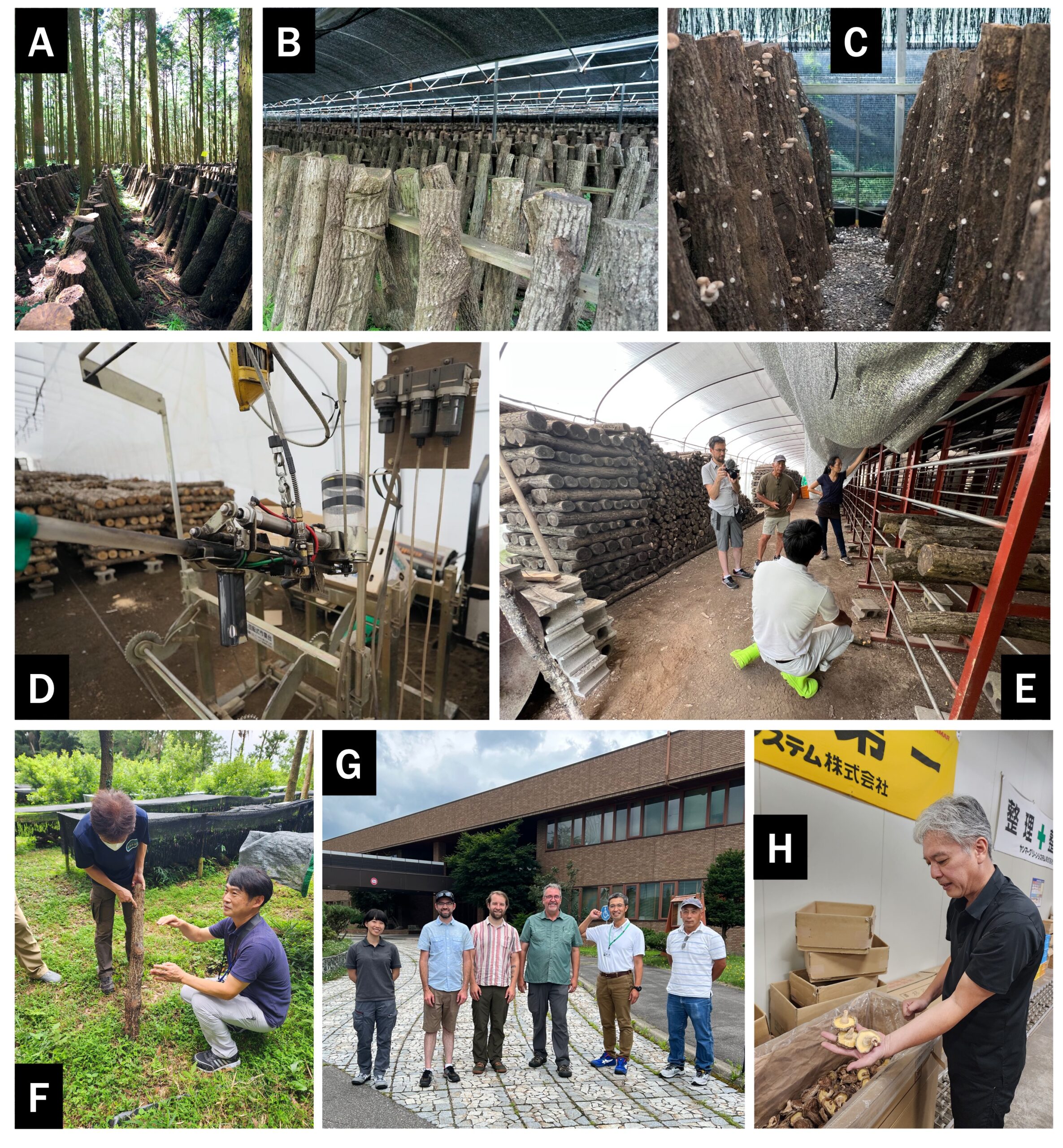
E5) In addition to seven trainings for participating growers, a PI O’Dea held a two-day short course in 2022 in Vancouver (23 attendees), a hands-on workshop (25 attendees) and a field day (42 attendees) in 2023 in Vancouver, a conference session at the OSU Small Farms School (29 attendees) in 2023, and two hands-on workshops in 2024 at Headwaters Farm Incubator in Gresham, OR (16 attendees), and in Vancouver (24 attendees). An additional hands-on workshop in Vancouver was scheduled for May 2024 due to demand.
PI-Shults gave a demonstration workshop in 2023 (30 attendees), and held a hands-on workshop in Olympia in 2024 (21 attendees), and presented on the project at the River Restoration Northwest Conference in Skamania, WA (~350 attendees). CO-PI Zobrist has a hands-on workshop planned for May, 2024, and Co-PI Jones has two hands-on workshops planned for Spring 2025.
For general project outreach, a CO-PI Jones hosted a shiitake mushroom tabling event at the Maple Conference in Portland, OR in 2023 reaching approximately 350 people. To date, the www.pnwforestmushroomgrowers.net website has accumulated 486 visits (459 unique, and 34 repeat visitors) and 731 page views. The project also received press coverage in 2023 through articles by WSU Insider and the Capital Press about the project and the visiting scholar tour of Japan.
E6) Multiple educational materials on forest-cultivated shiitake production have been drafted by PI O’Dea thus far. These include 1) a 20-page illustrated production guide, 2) a shiitake production enterprise budget worksheet/calculator, 3) a table of PNW-sourced log substrates for shiitake production, 4) a visual two-year production timeline, 5) an abbreviated “to-do” production startup checklist, and 6) an inoculation rate table. A guide intended for non-commercial shiitake growers (home gardeners, hobbyists etc.) was also drafted for publication by Co-PI Shults, PI O'Dea, and Co-PI Jones in 2024, after recognizing a need for a discrete forest-cultivated shiitake growing guide for this sector of the community. Otherwise, All draft production guide materials were supplied to all participating growers, and all workshop and participants as a reference for their production system setup. All participating growers are being solicited for feedback on the materials during year-end interviews throughout the project. After year 1, participating growers largely found that the production guidance materials provided by Extension to be helpful and thorough, although a few growers suggested improving clarity on the timeline of production activities and on strain selection. Many growers remarked that the hands-on trainings/workshops and mentorship were by far the most helpful educational components, and that if anything could be added to the guidance materials it would be instructional videos, as these would be the closest alternative to a hands-on, individualized educational experience.
The PNW Forest-Cultivated Mushroom Growers Network website (www.pnwforestmushroomgrowers.net) was initiated in 2022, with multiple pages published and public by 2024 (though with ongoing improvements being made), including the main home page, "About Us" and "Membership" headers, "Basics", "Timber", "Timber ID and Selection" (under Timber), "Inoculation", "Strains", and "Site" under the "Resources" header, and "Shiitake" under the "Mushrooms" header. The website will ultimately contain all the information provided through the draft guidance materials with additional video and and visual media, shiitake research summaries, links to printable guidance materials, and other resources for growers.
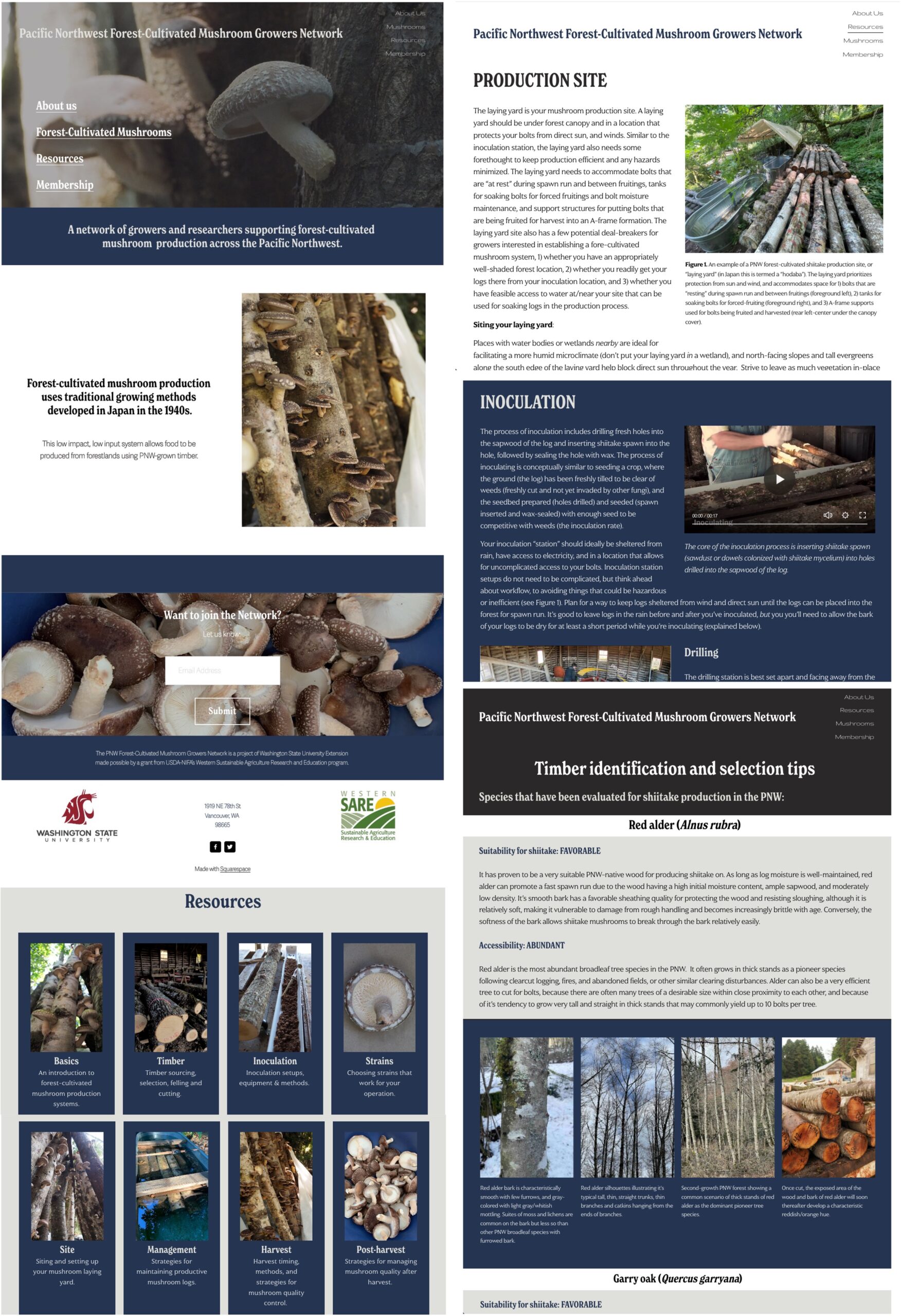
Education and Outreach Outcomes
The mentorship approach used in this project thus far appears to be an effective means for precipitating steps towards positive impact. All producers interviewed in year one indicated that the mentorship opportunity presented through this project either 1) directly incited them to begin growing shiitake for market, or 2) incited them to expand what they were doing on a non-commercial scale into an enterprise producing for market. For growers that actively made use of the mentorship opportunities presented through the project, they reported that the mentorship helped them make key decisions throughout the process of establishing their enterprise, avert costly mistakes, and importantly helped quell anxieties that arose about whether they were proceeding correctly/successfully or not. For growers that attended hands-on trainings, there was universal agreement that this component was the most powerful single educational approach used. Several of these growers remarked that if anything could be added to the guidance materials provided by Extension it would be instructional videos, as these would be the closest alternative to the hands-on, individualized educational experience they were getting out of the trainings and ongoing one-on-one mentorship. One grower that did not attend a training in 2023 remarked that the instructional videos made available so far to growers were a very helpful in helping them to better understand the information otherwise provided in the written materials. One grower also mentioned wanting to produce shiitake workshops in the future as part of their farm business model, indicating a value-added innovation and an active interest in becoming a peer mentor to other would-be growers.
Growers largely found the production guidance materials provided by Extension to be helpful and appreciated the thoroughness of detail provided, although a few growers suggested improving clarity on the timeline of production activities and on strain selection. Growers had a mixed response to how helpful it was to be networked to other new growers in year one. While some growers used the network to share resources, they also remarked that it was difficult to coordinate with each other, and that the opportunity to share information as a community in a meaningful way was not well-met via email or text. Some growers expressed that if there was a convenient platform to share field notes, media, updates, and questions (such as a social media group), this might be a more efficient approach to developing meaningful network interactions. This suggestion will be trialed for year two of the project to ascertain whether it better meets the needs of this educational objective.
All farms that have attended hands-on workshops were targeting learning how to grow shiitake for market. Post-event evaluations thus far have indicated significant knowledge gains, and intent to put knowledge gains to use. This includes intent to pursue shiitake enterprise development, but also also includes indications that workshops have informed some attendees decisions not to start an enterprise- an important, but under-appreciated outcome that saves would-be new growers the considerable expense of a potential business failure or dead-end.
- New enterprise development
- Best management practices
New enterprise development
Best management practices